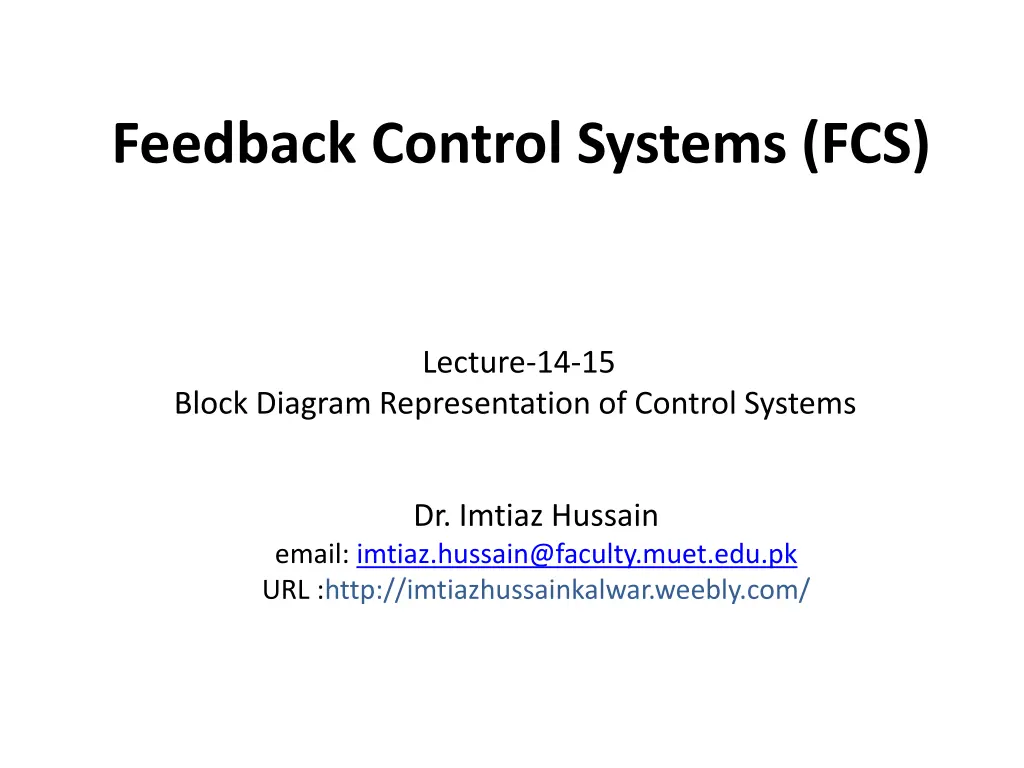
Understanding Block Diagram Representation in Feedback Control Systems
Learn about block diagrams as a pictorial representation of cause-and-effect relationships in feedback control systems. Explore the use of summing points, takeoff points, and examples illustrating block diagram creation for equations. Dr. Imtiaz Hussain provides valuable insights in these lectures. Visit the provided URL for more information.
Download Presentation

Please find below an Image/Link to download the presentation.
The content on the website is provided AS IS for your information and personal use only. It may not be sold, licensed, or shared on other websites without obtaining consent from the author. If you encounter any issues during the download, it is possible that the publisher has removed the file from their server.
You are allowed to download the files provided on this website for personal or commercial use, subject to the condition that they are used lawfully. All files are the property of their respective owners.
The content on the website is provided AS IS for your information and personal use only. It may not be sold, licensed, or shared on other websites without obtaining consent from the author.
E N D
Presentation Transcript
Feedback Control Systems (FCS) Lecture-14-15 Block Diagram Representation of Control Systems Dr. Imtiaz Hussain email: imtiaz.hussain@faculty.muet.edu.pk URL :http://imtiazhussainkalwar.weebly.com/
Introduction A Block Diagram is a shorthand pictorial representation of the cause-and-effect relationship of a system. The interior of the rectangle representing the block usually contains a description of or the name of the element, or the symbol for the mathematical operation to be performed on the input to yield the output. The arrows represent the direction of information or signal flow. d x y dt
Introduction The operations of addition and subtraction have a special representation. The block becomes a small circle, called a summing point, with the appropriate plus or minus sign associated with the arrows entering the circle. The output is the algebraic sum of the inputs. Any number of inputs may enter a summing point. Some books put a cross in the circle.
Introduction In order to have the same signal or variable be an input to more than one block or summing point, a takeoff point is used. This permits the signal to proceed unaltered along several different paths to several destinations.
Example-1 Consider the following equations in which x1, x2, x3, are variables, and a1, a2 are general coefficients or mathematical operators. = + x a x a x 5 3 1 1 2 2
Example-1 Consider the following equations in which x1, x2, x3, are variables, and a1, a2 are general coefficients or mathematical operators. = + x a x a x 5 3 1 1 2 2
Example-2 Consider the following equations in which x1, x2,. . . , xn, are variables, and a1, a2,. . . , an , are general coefficients or mathematical operators. = + + x a x a x a x n n n 1 1 2 2 1 1
Example-3 Draw the Block Diagrams of the following equations. dx 1 b 1 ) = + ( x a x dt 1 2 1 1 dt 2 d x dx 2 1 ) = + ( x a bx 2 3 3 1 1 2 dt dt
Characteristic Equation The control ratio is the closed loop transfer function of the system. ( ) ( s ) H C s G s =1 ( ) ( ) ( ) R s G s The denominator of closed loop transfer function determines the characteristic equation of the system. Which is usually determined as: = ( ) ( ) G s H s 1 0
Example-4 ) H s G s ) ( G s E ( B s = ( ) ( ) s 1. Open loop transfer function ( ) E C s = ( ) s 2. Feed Forward Transfer function ( ) (s ) G ( ) ( s ) H C s G s =1 3. control ratio + ( ) ( ) ( ) R s G s ( ) ( G ) ( ) B s G + s H s =1 4. feedback ratio ( ) ( ) ( ) R s s H s (s ) H ( ) E s 1 =1 5. error ratio + ( ) ( ) ( ) R s G s H s ( ) ( s ) H C s G s =1 6. closed loop transfer function + ( ) ( ) ( ) R s G s + = ( ) ( ) 7. characteristic equation G s H s 1 0 8. closed loop poles and zeros if K=10.
Reduction techniques 1. Combining blocks in cascade G G G 1G 1 2 2 2. Combining blocks in parallel G 1 G + G 1 2 G 2
Example-5: Continue. However in this example step-4 does not apply. However in this example step-6 does not apply.
Example-6 For the system represented by the following block diagram determine: 1. Open loop transfer function 2. Feed Forward Transfer function 3. control ratio 4. feedback ratio 5. error ratio 6. closed loop transfer function 7. characteristic equation 8. closed loop poles and zeros if K=10.
Example-6 First we will reduce the given block diagram to canonical form K + s 1
Example-6 K + s 1 K + G s 1 = K + + GH 1 + s 1 s 1
Example-6 ) H s G s ) ( G s E ( B s = ( ) ( ) s 1. Open loop transfer function ( ) E C s = ( ) s 2. Feed Forward Transfer function ( ) (s ) G ( ) ( s ) H C s G s =1 3. control ratio + ( ) ( ) ( ) R s G s ( ) ( G ) ( ) B s G + s H s =1 4. feedback ratio ( ) ( ) ( ) R s s H s (s ) H ( ) E s 1 =1 5. error ratio + ( ) ( ) ( ) R s G s H s ( ) ( s ) H C s G s =1 6. closed loop transfer function + ( ) ( ) ( ) R s G s + = ( ) ( ) 7. characteristic equation G s H s 1 0 8. closed loop poles and zeros if K=10.
Example-7 For the system represented by the following block diagram determine: 1. Open loop transfer function 2. Feed Forward Transfer function 3. control ratio 4. feedback ratio 5. error ratio 6. closed loop transfer function 7. characteristic equation 8. closed loop poles and zeros if K=100.
Reduction techniques 3. Moving a summing point behind a block G G G
3. Moving a summing point ahead of a block G G 1 G 4. Moving a pickoff point behind a block G G 1 G 5. Moving a pickoff point ahead of a block G G G
6. Eliminating a feedback loop G G 1 GH H G G 1 G = 1 H 7. Swap with two neighboring summing points A B B A
Example-8 H 2 C _ R G G G + + ++ _ 3 1 2 H 1
Example-8 H 2 G 1 C _ R G G G + + ++ _ 3 1 2 H 1
Example-8 H 2 G 1 C _ R G G 1G + + ++ _ 3 2 H 1
Example-8 H 2 G 1 C _ R G G 1G + + ++ _ 3 2 H 1
block diagram: reduction example H 2 G 1 C _ R G G 1 2 G + + _ 1 3 G G H 1 2 1
block diagram: reduction example H 2 G 1 C _ R G G G 1 G 2 3 H + + _ 1 G 1 2 1
block diagram: reduction example C R G G G 1 2 + 3 + 1 G G H G G H _ 1 2 1 2 3 2
Example-8 C R G + G G 1 2 G 3 H + 1 G G H G G G G 1 2 1 2 3 2 1 2 3
Example 9 Find the transfer function of the following block diagrams G 4 (s ) Y R (s ) G G G 1 2 3 H 2 H 1
I G 4 (s ) (s ) R Y B A G G G 3 2 1 H 2 G H 2 1 Solution: G 1. Moving pickoff point A ahead of block 2 2. Eliminate loop I & simplify B G + G G 4 2 3
G G (s ) R 4 (s ) Y G + G 3 2 G B A G G 4 1 3 2 H H 1G 2 2 G + G G 3. Moving pickoff point B behind block 4 2 3 II (s ) (s ) R Y B C G + G G G 4 2 3 1 H 2 H 1G G + 1 /( ) G G 2 4 2 3
4. Eliminate loop III (s ) (s ) R Y + G G G C C G + ( 2 H G 2 + G 3 G 4 4 G 2 G 3 G 1 + 1 ) H 4 2 3 2 G + H 2 1 G G G 4 2 3 Using rule 6 (s ) (s ) R Y + ( ) + G G G G 1 H 4 2 G 3 + + 1 ( ) G G H G G 1 2 1 2 4 2 3 + ( ) + ( ) G G G G Y s = = 1 G 4 + 2 3 ( ) T s + + + ( ) 1 ( ) ( ) R s G G H H G G G G G G 1 2 1 2 4 2 3 1 4 2 3
Example 10 Find the transfer function of the following block diagrams (s ) (s ) R Y G G 2 1 H H 2 1 H 3
Solution: 1. Eliminate loop I G I (s ) (s ) R Y 2 A B G H G G 2 1 + 1 H 2 2 H 2 1 H 3 G 2. Moving pickoff point A behind block 2 + 1 G H 2 2 (s ) (s ) R Y G A B G 2 + 1 1 G H 2 2 II + 1 G H H 2 2 + 1 1 G H G + ( ) 2 2 H H 2 3 1 G 2 H Not a feedback loop 3
3. Eliminate loop II (s ) (s ) R Y G + G 1 2 H 1 G 2 2 + 1 ( ) H G H + 1 2 2 H 3 G 2 Using rule 6 ( ) Y s G G + = = ( ) 1 2 G T s + + + ( ) 1 R s G H G G H H G G H H 2 2 1 2 3 1 1 1 2 1 2
Example 11 Find the transfer function of the following block diagrams H 4 (s ) R (s ) Y G G G G 3 2 1 4 H 3 H 2 H 1
Solution: G 1. Moving pickoff point A behind block I 4 H 4 (s ) R (s ) Y A B G G G G 3 2 1 4 1 H 3 H G H G 1 G 3 4 4 H 2 2 G 4 4 H 1
2. Eliminate loop I and Simplify (s ) R II (s ) Y G + G G 2 3 4 H B G 1 1 G G 3 4 4 H 3 G 4 H 2 III G 4 H 1 II III feedback Not feedback G G G + H G H 2 3 4 G 2 4 1 + 1 G G H G H G 3 4 4 2 3 3 4
3. Eliminate loop II & IIII (s ) (s ) R Y G G G G 1 2 3 4 + + 1 G G H G G H 3 4 4 2 3 3 H G H 2 4 1 G 4 Using rule 6 ( ) G G + G G Y s = = 1 2 G 3 G 4 G ( ) T s + + ( ) 1 R s G G H G G H H G G G G H 2 3 3 3 4 4 1 2 3 2 1 2 3 4 1
Example 12 Find the transfer function of the following block diagrams H 2 (s ) (s ) R Y A G G G 3 2 1 B H 1 G 4
Solution: G 1. Moving pickoff point A behind block I 3 H 2 (s ) (s ) R Y A B G G G 3 2 1 1 H G 1 3 1 H G 1 3 G 4
2. Eliminate loop I & Simplify H 2 B G 2G G B G 3 3 2 H+ 1 1 H H 2 G G 1 3 3 II (s ) (s ) R Y G G G 2 + 3 + 1 1 G H G G H 2 1 2 3 2 H 1 G 3 G 4
3. Eliminate loop II (s ) (s ) R Y G G G 1 2 3 + + + 1 G H G G H G G H 2 1 2 3 2 1 2 1 G 4 ( ) G G G Y s = = + 1 2 3 ( ) T s G 4 + + + ( ) 1 R s G H G G H G G H 2 1 2 3 2 1 2 1






















